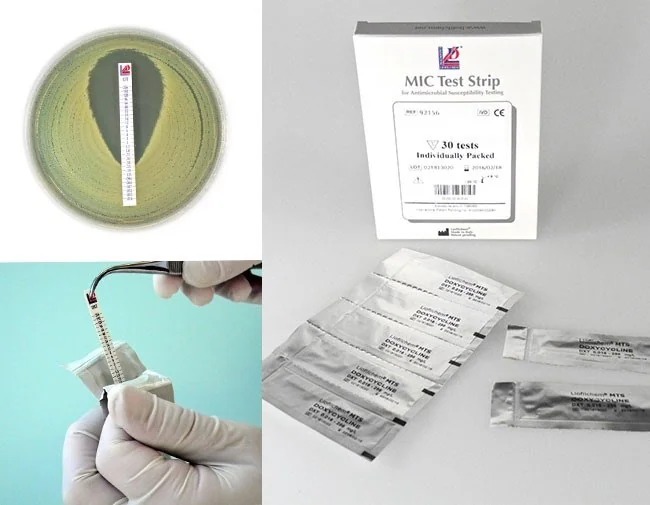Liofilchem™ MTS™ Chloramphenicol C 0.016-256, MIC Test strips
Catalog No :
CAS Number :
Brand :
In Stock
Specifications:
| Application | Clinical microbiology |
| Storage Temperature | -20°C |
| Product Type | MIC Strips |
| Product Brand | Liofilchem |
| Product Grade | Microbiology grade |
The Liofilchem™ MTS™ Chloramphenicol (C) 0.016–256 μg/mL MIC Test Strips are specialized tools designed for the precise determination of the Minimum Inhibitory Concentration (MIC) of chloramphenicol against various microorganisms. These strips are integral in assessing microbial susceptibility, guiding effective antimicrobial therapy, and monitoring resistance patterns.
Test Procedure:
- Inoculum Preparation:
- Select well-isolated colonies from an overnight culture.
- Suspend the colonies in sterile saline or broth to achieve a turbidity equivalent to a 0.5 McFarland standard.
- Inoculation of Agar Plate:
- Dip a sterile swab into the prepared inoculum suspension.
- Remove excess liquid by pressing the swab against the tube wall.
- Evenly streak the swab over the entire surface of a Mueller-Hinton agar plate to ensure a uniform lawn of growth.
- Application of MTS™ Strip:
- Allow the inoculated plate to dry for approximately 15 minutes at room temperature.
- Using sterile forceps, place the MTS™ Chloramphenicol strip onto the agar surface with the concentration scale facing upward.
- Ensure complete contact between the strip and the agar surface; do not reposition once applied.
- Incubation:
- Incubate the plate in an inverted position at 35 ± 2°C for 16–20 hours under ambient atmospheric conditions.
- Reading and Interpretation:
- After incubation, observe the plate for an elliptical zone of inhibition around the strip.
- Determine the MIC by identifying the point on the scale where the edge of the inhibition ellipse intersects the strip.
- Interpret the MIC value using established clinical breakpoints from CLSI or EUCAST guidelines.
Comparison with Other Brands:
Several manufacturers offer MIC test strips for chloramphenicol, including bioMérieux's ETEST® and HiMedia's HiComb MIC Test Strips. Below is a comparative overview:
| Feature | Liofilchem™ MTS™ Chloramphenicol | bioMérieux ETEST® Chloramphenicol | HiMedia HiComb MIC Test Strips |
|---|---|---|---|
| Concentration Range | 0.016–256 μg/mL | 0.016–256 μg/mL | 0.016–256 μg/mL |
| Material | High-quality paper | Plastic | Plastic |
| Storage Conditions | 2–8°C | 2–8°C | 2–8°C |
| Shelf Life | Refer to packaging | Refer to packaging | Refer to packaging |
| Packaging Options | 10, 30, or 100 strips per pack | 30 strips per pack | 10 or 50 strips per pack |
| Compliance | CLSI and EUCAST guidelines | CLSI and EUCAST guidelines | CLSI and EUCAST guidelines |
Advantages of Liofilchem™ MTS™ Chloramphenicol Strips:
- Material Quality: Made of high-quality paper, which may offer better adherence to the agar surface compared to plastic strips, potentially leading to more accurate results.
- Packaging Flexibility: Available in various pack sizes (10, 30, or 100 strips), allowing laboratories to choose quantities that best fit their testing frequency and budget.
- Cost-Effectiveness: Generally more affordable than some competitors, making them a cost-effective choice for routine laboratory use.
- Wide Range of Antimicrobials: Liofilchem offers a broad spectrum of MIC test strips for over 150 antimicrobial agents, providing comprehensive testing options.
In summary, Liofilchem™ MTS™ Chloramphenicol MIC Test Strips provide a reliable, flexible, and cost-effective solution for determining the MIC of chloramphenicol, with advantages in material quality and packaging options over some competitors.
- Pack Size: 100/pk 10/pk 30/pk




 0
0
